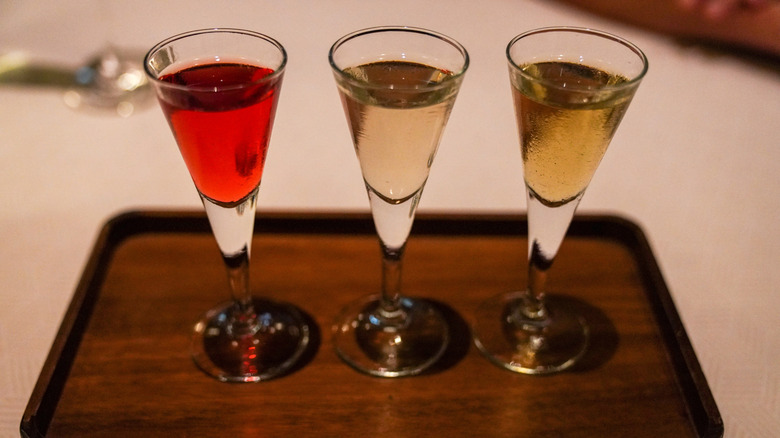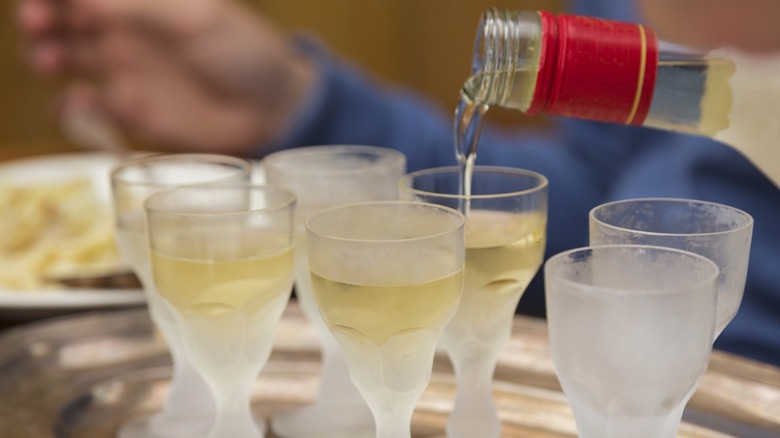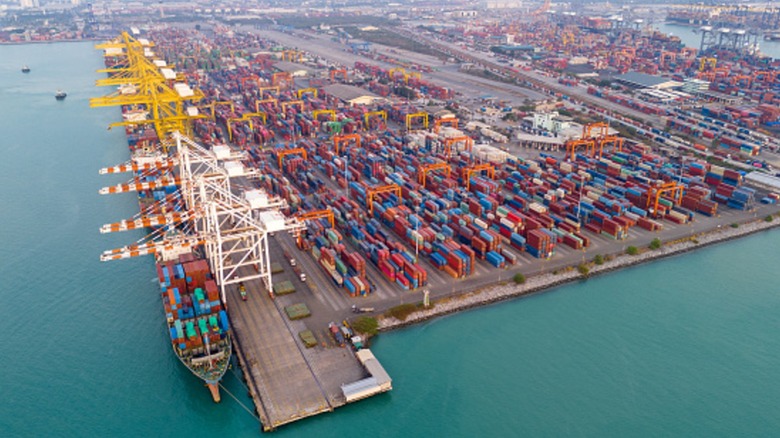The Liquor That Travels Around The World To Age
They say that good things come to those who wait, and in the world of food and drink, that statement seems to ring true more often than not. The concept of letting things sit and age is a familiar one in the culinary sphere — dry-aged beef is one of the not-so-secret ways that restaurants produce stunning steaks, and aging is an essential aspect of creating top-tier hot sauces. And when you move over into the world of beverages and spirits, this credo is no different. But while liquors go through different aging processes, there's one European spirit that experiences what is a truly unique aging method.
Aging is a virtually essential process for many liquors, and indeed, some liquors, like certain whiskeys, have actual laws centered on their aging regulations. Normally, aging a liquor involves storing it in a cask inside a storehouse for a certain amount of time, allowing the wood from the barrels to incorporate extra flavor into the spirit. But Linie, a Norwegian brand of aquavit, is not what you'd call a homebody. Instead of residing in a cellar or warehouse, Linie packs its casks of aquavit onto a shipping vessel, and then they undergo a naval journey that takes place over several months and across the equator. This is certainly a unique way to age one's product, but there's actually some sound reasoning behind Linie's commitment to this process, even if it may have started out as a happy accident.
When it comes to aging, climate matters
Since one of the key points of aging liquor is to impart the barrel wood's flavor notes into the spirit, ideally, you want to have your distillery in a climate that allows the wood to "open up" as best as it can so that the spirit can more easily integrate with it. Climates that are more humid and shifting can achieve this more easily than others, leading to comparatively shorter aging processes; this is one reason American bourbon tends to have lower age statements than Scotch, for example.
Linie understands this when it comes to their aquavit. The voyage that the distillery sends its liquor on experiences drastically different climates as it crosses over the equator twice and winds through parts of three oceans. These climate changes allow the wood to breathe a lot more, thus allowing more flavor to be instilled into the product.
As it turns out, this whole process may have started unintentionally. According to Linie itself, the Oslo-based distiller sent a batch of its product to India back in 1805. Much of the spirit was sent back to Norway after it failed to catch on abroad; however, the voyage to and from India seemed to have imparted much more flavor into the spirit, thus beginning a tradition of seaward aging that Linie upholds to this day.
What is aquavit, and how do you drink it?
Aquavit is definitely a lesser-known spirit this side of the Atlantic. However, in parts of Europe, it's highly recognized and is particularly beloved in different parts of Scandinavia. The spirit is a type of "eau de vie," which is where its name, derived from "aqua vitae," comes from. While certain brands of aquavit are made with different ingredients, it's typically a neutral spirit flavored by herbs such as caraway, fennel, dill, and anise. These ingredients, alongside its aging inside wooden casks (sherry casks aren't uncommon), give it a herbal, woodsy flavor that's sure to warm the belly on cold Nordic nights.
When it comes to serving aquavit, some treat it the same as they would an aged añejo tequila and drink it neat. However, if sipping or shooting isn't for you, then aquavit can also prove to be an excellent substitute for vodka in a bloody mary. Aquavit has even made its presence felt in a Disney theme park, where Linie's world-traveled product features in the Norway section of Epcot's World Showcase. Thankfully, aquavit isn't quite as obscure and region-specific as it once was, so unlike Linie's marquee spirit, you're not going to have to go on a months-long voyage across the ocean just to get your hands on some.
Is this aging process unique to Linie?
With such an adventurous and creative aging process, you might be wondering if there are any other aquavit distillers that utilize similar practices for their products. While Linie seems to be the only aquavit producer that uses its nearby coastline to its advantage, a quick look at other alcoholic beverages reveals a few more players in this high-seas game. Closer to home, the American bourbon producer, Jefferson's, has a line of bourbons and other whiskeys that are sent on voyages to age, similar to that of Linie's aquavit –- even going so far as to keep a detailed log of the weather conditions and ports docked at for each journey.
While these spirits enjoy aging processes aboard their respective ocean liners, some winemakers also use the ocean to improve their aging process -– just not in the way Linie and Jefferson's do. Underwater aging is a fascinating method by which wine producers submerge their products as they age, taking advantage of the relatively consistent temperature and pressure levels of the ocean just off their respective country's shoreline. While distinct from the seafaring exploits of certain aquavits and bourbons, it's just one more creative way that alcohol producers are using natural features to make unique and intriguing aged goods.



